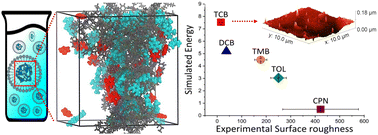Effect of solvent on the emulsion and morphology of polyfluorene films: all-atom molecular dynamics approach†
Abstract
The morphology of conjugated polymer thin films deposited by the resonant infrared matrix-assisted pulsed laser evaporation (RIR-MAPLE) process is related to the emulsion characteristics. However, a fundamental understanding of how and why the emulsion characteristics control the film properties and device performance is yet unclear. We performed all-atom molecular dynamics simulations of emulsions containing a mixture of polyfluorene (PFO) polymer, various primary solvents, secondary solvent, and water. The emulsion properties were then examined as a function of variable primary solvent and correlated with the morphology of deposited PFO thin films. The examination of the explicit interactions between all components of the emulsion indicated that using a primary solvent with a lower solubility-in-water and a higher non-bonded interaction energy ratio, between the solvent, polymer, and water in the emulsion recipe, produced the best result with smoother and denser films. Additionally, our simulation results are consistent with the AFM experimental results, indicating that interactions driven by trichlorobenzene (TCB) primary solvent within the emulsion are responsible for high-quality, smooth, and continuous thin film surfaces. Overall, this study can support the choice of a suitable primary solvent and provides the computational framework for predictions of new recipes for polymeric emulsion systems.



 Please wait while we load your content...
Please wait while we load your content...
